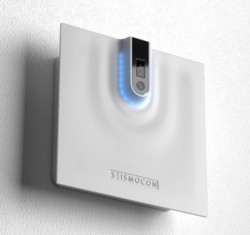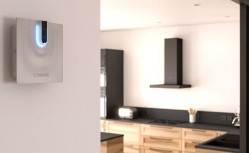
© CEOCFO Magazine -
CEOCFO Magazine, PO Box 340
Palm Harbor, FL 34682-
Phone: 727-
Email: info@ceocfocontact.com


Search





Business Services | Solutions
Medical | Biotech
Cannabis | Hemp
Banking | FinTech | Capital
Government Services
Public Companies
Industrial | Resources
Clean Tech
Global | Canadian
Lynn Fosse, Senior Editor
Steve Alexander, Associate Editor
Bud Wayne, Marketing
& Production Manager
Christy Rivers -



 -
-
Seismocon Systems -
 Mike Sjoblom
Mike Sjoblom
CEO
Seismocon Systems, Inc.
Contact:
Mike Sjoblom
707-
Interview conducted by:
Lynn Fosse, Senior Editor
CEOCFO Magazine
Published – August 29, 2022
CEOCFO: Mr. Sjoblom, Seismocon recently received a new patent. What is the concept behind the company?
Mr. Sjoblom: We have developed and is currently building a system for regular people to understand how safe their homes are after a natural disaster, especially an earthquake.
 CEOCFO: Why is there not something yet in place for people to realize what is going on and what they should be aware of after a quake?
CEOCFO: Why is there not something yet in place for people to realize what is going on and what they should be aware of after a quake?
Mr. Sjoblom: I think people are not thinking out-
After the 2014 Napa earthquake, I wanted to know if my house was safe to use. Earthquakes come in swarms. Was this a foreshock or the main shock? The important question remained unanswered; is it safe to go back in the house? United States Geological Survey says: “Earthquakes do not kill people, buildings do.”. The system we developed is measuring and monitoring the structural integrity to assure that the house is safe to go inside after an earthquake.
CEOCFO: How does it work?
Mr. Sjoblom: The monitoring unit is a small box including a great number of sophisticated sensors. I call it the black box, similar to what is found in an airplane. The box is placed on a wall inside your house. The sensors monitor the structure 24/7, everything from distance with lasers, angles, vibrations, sound, position, and environmental conditions such as weather, etc. The system customizes the exact data and footprint of your house because each house reacts differently depending on building material and type, where it is located -
It is important to say that we do not really monitor any natural disasters. We don’t look for the cause of the incident. It can be wind, an explosion or earthquake, flood or landslide. We only look at your house. When something happens in the house, our system knows exactly your house data. Analysis is made using existing and actual data, with data recorded during the incident of the house, and compare new data of the house after the incident. Based on the proprietary analysis process, we will send you a text message only minutes after it happens. The messages are recommendations and advises what you should do, which we believe will save lives in the future.
CEOCFO: How did you know when you have enough AI?
Mr. Sjoblom: It is not about the amount of data; it is more to identify the exact data. As an example, the laser (LiDAR) identifies the length of your room by the millimeter. In the ongoing data acquisition process the system identifies a discrepancy of the threshold value of your house, something is wrong. We don’t know why; we only know that the structure has been displaced and it can result in danger for the occupants. It is not so much that we need to collect multiple data, we are collecting a certain set of data that we identify, compare and store.
The AI understand the unique structural measurements of your house based on the sensor data. The algorithm includes cross-
CEOCFO: You are a serial entrepreneur and involved in consumer electronics. In Seismocon, is it the business side, the technical side, or both, that you have been involved in as the company and product has grown and evolved?
 Mr. Sjoblom: I have my fingers in each part of it. The good thing of not having just graduated from one of these amazing universities in the country, but you actually have some experience and some grey hair, is that that you have experience and know how to build. Secondly, it is people. My network of people I involved are very competent and know what they are doing. I know that since we worked together before. We are not talking about a creative business plan to raise capital because the funding come from myself, friends and family. We have come together to develop this based on the fact that we think this is needed. With that said, we do have both a business and development plan, but not to share with outside sources.
Mr. Sjoblom: I have my fingers in each part of it. The good thing of not having just graduated from one of these amazing universities in the country, but you actually have some experience and some grey hair, is that that you have experience and know how to build. Secondly, it is people. My network of people I involved are very competent and know what they are doing. I know that since we worked together before. We are not talking about a creative business plan to raise capital because the funding come from myself, friends and family. We have come together to develop this based on the fact that we think this is needed. With that said, we do have both a business and development plan, but not to share with outside sources.
The NAPA M6.1 earthquake happened in 2014 and I was surprised to find that there is nothing for me as a regular person or resident in a house, to understand the dangers. I was as oblivious as everyone else but my creative brain got triggered and something had to be done here. Our motivation from the get-
If you look at the Ring of Fire from Chile all the way up to Alaska, Japan, to Indonesia, there are billions of people who live in earthquake-
CEOCFO: What is involved with the homeowner when they get a unit?
Mr. Sjoblom: We try to make this system affordable for people because there are systems today that cost hundreds of thousands of dollars, even millions of dollars that are put into skyscrapers. As a regular homeowner you cannot afford that, so my target is that it should not cost more than $10 to $20 a month. This technology is expensive. We have looked into what the cellphone industry has done, they give you a phone for $1000 when you sign on to a contract with a subscription agreement. I think that is a smart way to keep costs down for people and get access to the system which in return once it happens will really help to guide them.
CEOCFO: What surprised you through the development process?
Mr. Sjoblom: If you can imagine eight years of work with a handful of people, we all have been working with a good heart. We have not looked at the number of hours we put into it. It has been a separate project that we have been running and just taking the time it takes to get this in place because there is lots of research. We have distinguished professors from three continents that has been involved in this. They have all given their good heart into this like we all have. The cost itself has been minimal if you look at money out, but the time put into it has been quite the opposite.
CEOCFO: What is your plan for commercialization?
Mr. Sjoblom: We are now testing the system and its algorithms. The tests are in lab environments and we are soon going to make installations in a couple of areas just to have real data from buildings but right now it is still a lab product so to speak. We are testing the capacity of the components etcetera. That is where we are today. I expect to have really all the components tested out by spring 2023. We are then ready for production.
By mid to end of next year we should be able to start to deliver. We have a few large insurance companies that are interested. We have homeowners associations and we have interest from the industry from other types of industries. We will take this piece by piece and put it in place as it comes.
CEOCFO: Why is Seismocon Systems so important?
Mr. Sjoblom: Over the years I have been following everything that has been happening on the private sector but especially on the governmental space in local, state and federal. The congress signed documents only a year-
What we collect is that particular thing that everyone is asking for because without data, all you can do is to suggest and guestimate. The science is really good, but the last piece of the puzzle is actually real data from real buildings and real events from multiple thousands of houses. That is one thing that I realize will be very useful for both counties, cities, and even Washington D.C. That is one reason why this is so important. I want to go back to the fact that this was all born in the rubble of the 2014 earthquake for myself. I did not start this with those thoughts, I started it because I personally craved and needed information about my own house and I could not get it. I want to help people be able to make a good decision for themselves and their families. What everyone is really talking about is immediate occupancy. This is a technical term, which means that in order to get society back on track after a natural disaster, you need to get them back into their homes, you need to get them back into the workplace but if you do not know the safety of these buildings, the natural progression of a city is that they red-
The difference between the structural engineers and our system is that a structural engineer 99% of the time has never seen your home before so they do not what it looked like before. They look for cracks, if the roof is in place, if the foundation is in place, etc. Immediately after an incident there are 100s of houses to inspect and usually very few structural engineers. It is therefore natural that it takes a long time before these professionals have done its surveys at the entire structural inventory in the area. After the Napa quake it took five weeks for Napa County to really do the inventory inspection. If our system would have been in place, and especially all the county buildings from schools to libraries and such places, we would be able to provide that list of inventory safety standard within ten minutes. This is because our system immediately identifies what happened to each and every structure and enables the structural engineers to go directly to the prioritized list our system produces.
Seismocon Systems, Inc. | Mike Sjoblom | Earthquake Home Safety | Home Structural Integrity | Seismocon Systems -
“The difference between the structural engineers and our system is that a structural engineer 99% of the time has never seen your home before so they do not what it looked like before.”
Mike Sjoblom